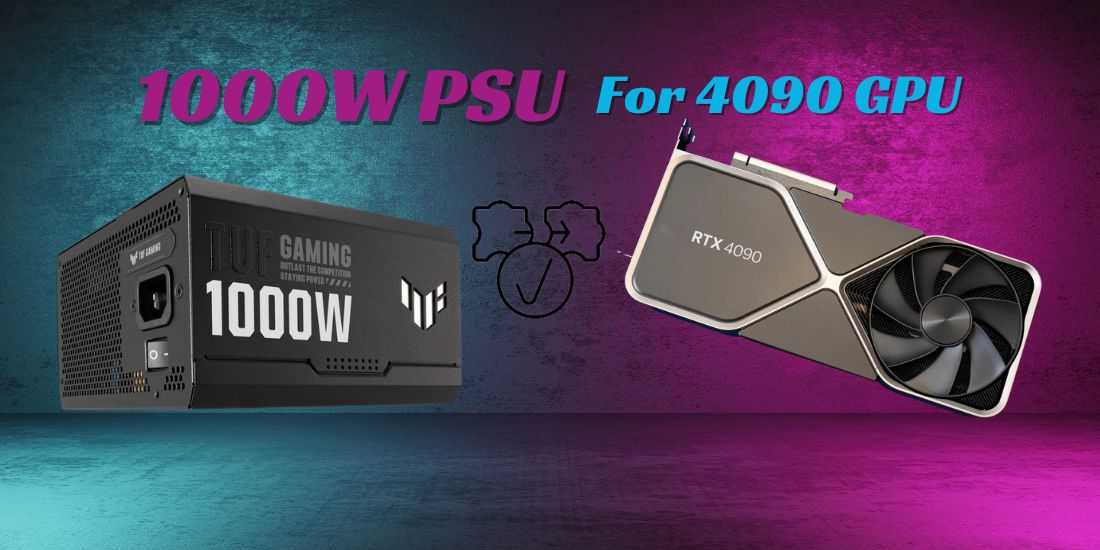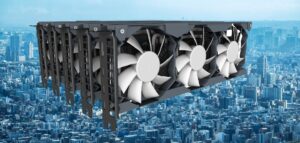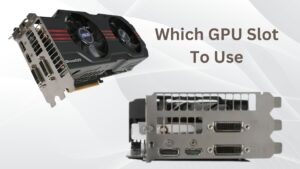Is 1000W PSU Enough For 4090 GPU?
Choosing the right power supply unit (PSU) is crucial when building a high-performance PC, especially when it comes to powering hardware like the NVIDIA GeForce RTX 4090. As one of the most powerful GPUs on the market, the RTX 4090 delivers exceptional performance but also demands a significant amount of power. With a maximum power draw of 450 watts, ensuring your PSU can handle the load is essential for stable operation. Many users wonder, “Is a 1000W PSU enough for the RTX 4090?” The answer is generally yes, but it depends on other factors such as your CPU, peripherals, and potential upgrades. This article explores the power requirements of the RTX 4090, how a 1000W PSU fits into different system configurations, and why PSU quality matters just as much as wattage. By the end, you’ll know if a 1000W PSU is the right choice for your build.
Understanding GPU Power Dynamics:
GPUs (graphics processing units) are the powerhouse behind modern computing, handling demanding tasks like gaming, video rendering, AI processing, and more. However, with great power comes great energy consumption. Understanding GPU power dynamics is essential for ensuring system stability, choosing the right PSU, and optimizing performance.
1. How GPUs Consume Power:
GPUs require power to run their cores, memory, cooling systems, and other onboard components. The amount of power a GPU draws depends on several factors:
- Core Load: The more demanding the task (e.g., gaming or 3D rendering), the higher the power consumption.
- Clock Speeds: Overclocking increases power requirements by boosting GPU core and memory speeds.
- Power States: GPUs dynamically adjust their power usage based on the workload, running at lower power during idle states.
2. Measuring GPU Power Draw:
The power draw of a GPU is measured in watts (W) and is often referred to as its TDP (Thermal Design Power). For example, an NVIDIA RTX 4090 has a TDP of 450W. TDP indicates the maximum heat the GPU generates, which correlates to its power consumption. Monitoring tools like HWMonitor or MSI Afterburner can display real-time power usage for GPUs.
3. The Role of PSU in Power Delivery:
A GPU’s power comes from the PSU, connected via PCIe cables. Modern GPUs often use:
- 8-pin PCIe Connectors: Common for high-performance GPUs.
- 12-pin or 16-pin PCIe Connectors: Found in newer GPUs like the RTX 4090, requiring adapters or compatible PSUs. An insufficient PSU can lead to power throttling, instability, or system crashes.
4. Overclocking and Power Consumption:
Overclocking a GPU increases its voltage and clock speeds, resulting in higher power consumption. This can cause spikes in power usage beyond the GPU’s rated TDP. To accommodate overclocking, it’s essential to choose a PSU with enough headroom to handle these power demands.
5. Power Efficiency and GPU Performance:
Modern GPUs are designed for efficiency, balancing performance with power usage. GPUs with advanced architectures, such as NVIDIA’s Ada Lovelace or AMD’s RDNA 3, offer higher performance per watt, reducing overall energy consumption compared to previous generations.
6. Cooling and Power Management:
Efficient cooling is crucial for managing GPU power dynamics. A GPU running at higher temperatures may throttle its performance to prevent overheating, which can affect its power efficiency. Proper airflow and adequate cooling solutions help maintain optimal power and performance.
7. Why Power Dynamics Matter:
Understanding GPU power dynamics ensures you can:
- Select the Right PSU: Avoid insufficient power supply that can cause instability or hardware damage.
- Optimize Performance: Balance clock speeds and power usage to achieve the best performance.
- Ensure Compatibility: Match your PSU connectors and wattage with your GPU’s requirements.
How Much Power Does the RTX 4090 Require?
The NVIDIA RTX 4090 is a flagship GPU designed for gaming, rendering, and other demanding tasks. It has a maximum power draw of 450 watts, making it one of the most power-hungry consumer GPUs available. NVIDIA recommends a minimum 850W PSU for systems running the RTX 4090. However, this recommendation assumes a standard system configuration without overclocking or additional components. A 1000W PSU offers more than enough wattage for the RTX 4090 and ensures headroom for other components, making it a safe and reliable choice for most users.
What Components Impact Power Consumption?
While the RTX 4090 itself requires 450W, the total power consumption of your system depends on other hardware. Let’s break it down:
- CPU
High-end CPUs like the Intel Core i9-13900K or AMD Ryzen 9 7950X can consume 200W or more under heavy loads. If overclocked, their power usage increases further. - Motherboard and RAM
These components typically draw around 50-100W combined. - Storage Drives and Peripherals
SSDs, HDDs, fans, and RGB lighting may add 50-100W to the total power requirement. - Overclocking
If you plan to overclock the RTX 4090 or your CPU, it will increase power draw significantly. Overclocked GPUs can push the power usage beyond 500W, while CPUs can consume an extra 50-100W during overclocking.
When you add everything up, a typical high-performance system with the RTX 4090 and a high-end CPU can require 750-850W under load. A 1000W PSU ensures there is enough headroom for stability and future upgrades.
Why a 1000W PSU Is a Good Choice?
A 1000W PSU offers several advantages for a system with an RTX 4090:
- Ample Headroom
Power supplies operate most efficiently when used at 50-70% of their capacity. A 1000W PSU running at 750W (for example) is more efficient than an 850W PSU operating near its limit. - Future-Proofing
With a 1000W PSU, you won’t need to worry about upgrading your power supply if you decide to install more power-hungry components later, such as additional storage drives or new hardware. - Overclocking Stability
Overclocking increases power consumption and generates heat. A 1000W PSU ensures that your system remains stable and has enough power to support overclocking without issues. - Efficiency and Longevity
High-quality PSUs with 80 PLUS Gold, Platinum, or Titanium ratings are designed to run efficiently and last longer. A 1000W PSU provides better energy efficiency, generates less heat, and reduces wear on components compared to a smaller PSU running at full capacity.
Consider the PSU’s Quality, Not Just Wattage:
When selecting a power supply unit (PSU) for your system, wattage is important, but quality is even more critical. A high-wattage PSU may seem sufficient on paper, but if it’s poorly made, it can lead to instability, inefficiency, or even damage to your components. Here’s why PSU quality matters just as much as wattage:
1. Efficiency Matters:
A high-quality PSU will have an 80 PLUS certification, indicating its efficiency. Higher certifications (Gold, Platinum, or Titanium) mean less energy is wasted as heat, reducing electricity bills and ensuring stable power delivery to your components. An efficient PSU also generates less heat, improving overall system cooling.
2. Reliable Power Delivery:
Premium PSUs provide consistent and clean power, preventing voltage fluctuations that can harm sensitive components like the GPU, CPU, or motherboard. Low-quality PSUs may fail to maintain stable voltages under load, leading to crashes or performance issues.
3. Build Quality and Longevity:
Reputable brands use high-quality materials, such as durable capacitors and cooling components, to ensure reliability and longevity. Cheap PSUs often cut corners, leading to shorter lifespans and a higher likelihood of failure.
4. Protection Features:
Good PSUs come with safety features like overcurrent protection (OCP), overvoltage protection (OVP), and short-circuit protection (SCP). These features safeguard your hardware from potential power-related damage in case of a fault.
5. Brand Reputation:
Trusted brands like Corsair, EVGA, Seasonic, and Thermaltake consistently deliver PSUs that meet rigorous standards. Reading reviews and user feedback can help you identify reliable models.
When Might You Need More Than 1000W?
While a 1000W PSU is sufficient for most high-performance systems, there are specific scenarios where a PSU with more than 1000W may be necessary. Let’s explore when you might need additional wattage for your setup:
1. Running Multiple GPUs:
- If your system uses more than one GPU, such as in SLI or NVLink configurations, power consumption increases significantly. High-end GPUs like the RTX 4090 can draw 450W or more each, meaning a dual-GPU setup could exceed the capacity of a 1000W PSU. A PSU with 1200W or higher ensures stable power delivery in such cases.
2. High-End Systems With Extreme Overclocking:
- Overclocking your CPU and GPU increases their power demands beyond stock levels. For enthusiasts who push their components to the limit, especially with flagship processors and GPUs, a PSU with more than 1000W is often required to maintain stability and accommodate the power spikes caused by overclocking.
3. Workstations With Multiple Components:
- Workstations designed for tasks like video editing, 3D rendering, or scientific simulations often include multiple storage drives, add-on cards, and cooling systems. These components can significantly increase overall power consumption. A PSU with 1200W or higher can handle the load of such complex configurations.
4. Custom Liquid Cooling Loops:
- Custom water-cooling loops with multiple pumps, radiators, and fans require extra power. Combined with high-performance components, these systems can demand more than 1000W, especially under load.
5. Future-Proofing for Upgrades:
- If you plan to expand your system in the future—such as adding more GPUs, storage drives, or other peripherals—it’s worth considering a PSU with more than 1000W. This provides the flexibility to accommodate upgrades without needing to replace the PSU later.
6. Extreme Builds and Server-Grade Systems:
- Extreme builds with specialized components, such as server-grade motherboards, dual processors, or redundant power supplies, can require significantly more power. Systems used in AI training, cryptocurrency mining, or other power-intensive workloads often require 1500W or more.
Comprehensive Power Considerations:
1: Total System Power Draw:
Unquestionably, the GPU is a voracious consumer of power, but it’s not the sole player in the energy game. Calculating the cumulative power requirements of the entire system is paramount. The CPU, RAM, storage devices, cooling solutions, and peripherals all contribute to the overall power consumption equation.
2: Future-Proofing:
Anticipating future upgrades is a strategic move. If plans include additional GPUs, a more power-hungry CPU, or expanded storage, opting for a higher-wattage PSU provides headroom for these endeavours without necessitating a premature power supply upgrade.
3: Efficiency Ratings:
The efficiency of a PSU, often expressed through certifications like 80 PLUS Gold or Platinum, impacts energy consumption. A higher efficiency rating signifies less wasted power, translating to potential savings on electricity bills over the system’s lifespan.
4: Modular vs. Non-Modular PSUs:
The modular design of a PSU introduces an element of customization, allowing users to connect only the necessary cables. This not only enhances airflow within the case but also contributes to a cleaner and more manageable system.
The Role of a 1000W PSU:
A 1000W PSU plays a vital role in powering high-performance PCs, especially those with demanding components like the NVIDIA RTX 4090 or high-end CPUs. It provides sufficient wattage to handle power-hungry tasks like gaming, rendering, and overclocking while ensuring system stability and reliability. With ample headroom, a 1000W PSU supports future upgrades, such as additional GPUs or storage drives, without risking power shortages. High-quality 1000W PSUs with 80 PLUS certifications also deliver efficient energy usage, reducing heat and power waste. In essence, a 1000W PSU ensures consistent performance, long-term flexibility, and optimal power delivery for advanced systems.
Conclusion
A 1000W PSU is more than sufficient to power a system featuring the NVIDIA RTX 4090 GPU, provided it’s a high-quality unit with reliable efficiency ratings like 80 PLUS Gold or higher. With a power draw of 450W, the RTX 4090 leaves ample headroom for your CPU, storage drives, cooling system, and other peripherals in most builds. Choosing a 1000W PSU ensures stability, supports overclocking, and prepares your system for future upgrades.
However, it’s important to consider the overall quality of the PSU rather than just focusing on wattage. Opting for a reputable brand ensures consistent performance and prevents potential hardware issues. While extreme setups, like multi-GPU systems or custom loops, may require more power, for most users, a 1000W PSU is the perfect balance of power, efficiency, and future-proofing. Make the right investment, and your system will deliver outstanding performance for years to come.
FAQs
1. Is a 1000W PSU overkill for the RTX 4090?
No, a 1000W PSU is not overkill for the RTX 4090. While the GPU itself has a power draw of 450W, other components like the CPU, motherboard, and storage drives contribute to the total power consumption. A 1000W PSU ensures headroom for stability, overclocking, and future upgrades.
2. Can I use an 850W PSU for the RTX 4090?
Yes, you can use an 850W PSU for the RTX 4090 if you have a standard setup without power-hungry components or heavy overclocking. However, a 1000W PSU provides additional headroom and is a better option for long-term performance and flexibility.
3. What PSU efficiency rating is best for the RTX 4090?
An 80 PLUS Gold, Platinum, or Titanium-rated PSU is recommended for the RTX 4090. These certifications ensure high efficiency, stable power delivery, and reduced energy waste, which are crucial for high-performance builds.
4. Will a 1000W PSU reduce my electricity bill?
A 1000W PSU itself does not reduce electricity usage. However, a high-quality PSU with an 80 PLUS certification operates more efficiently, wasting less power as heat. This can result in slightly lower energy consumption compared to lower-efficiency PSUs.
5. Do I need a special connector for the RTX 4090?
Yes, the RTX 4090 uses a 16-pin PCIe 5.0 power connector, which is included with the GPU. Ensure your PSU is compatible or use the included adapter if your PSU has multiple 8-pin connectors. Many modern high-wattage PSUs now come with native support for PCIe 5.0.
Last Updated on 28 January 2025 by Ansa Imran

Ansa Imran, a writer, excels in creating insightful content about technology and gaming. Her articles, known for their clarity and depth, help demystify complex tech topics for a broad audience. Ansa’s work showcases her passion for the latest tech trends and her ability to engage readers with informative, well-researched pieces.







